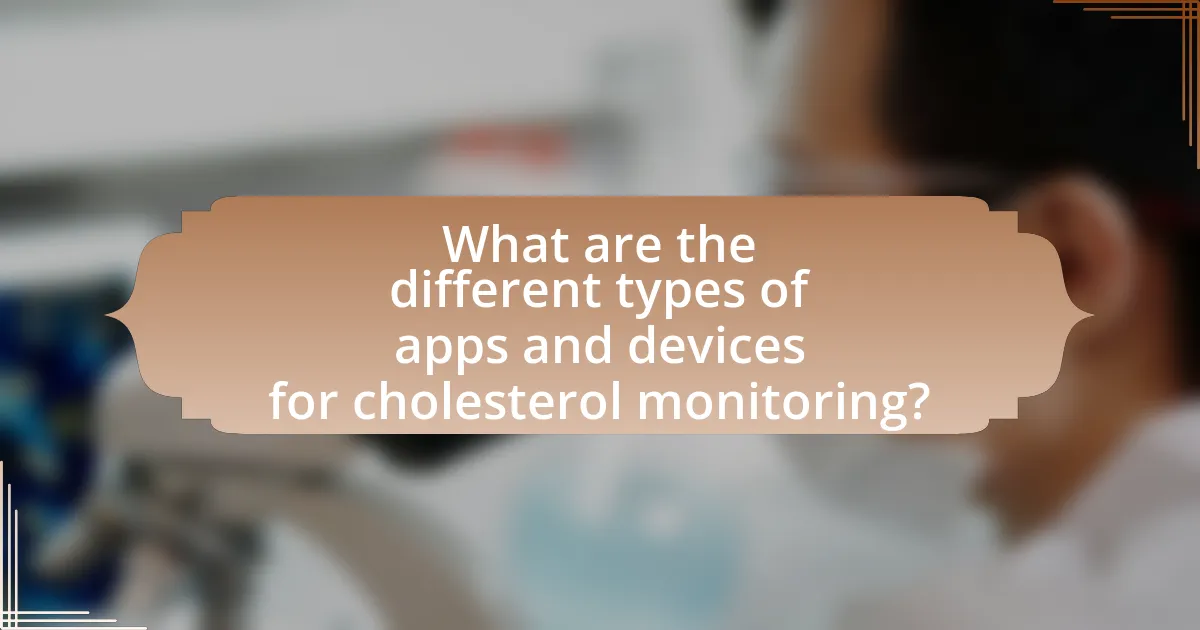Integrating technology in cholesterol monitoring involves the use of digital tools such as mobile applications, wearable devices, and telehealth platforms to effectively track and manage cholesterol levels. This article explores how technology enhances cholesterol monitoring through real-time data collection, various types of devices, and the importance of regular monitoring for cardiovascular health. It discusses the features users should look for in cholesterol monitoring apps, the advantages of wearable devices, and best practices for effective integration of technology into health routines. Additionally, the article highlights future trends, including advancements in biosensors and the role of artificial intelligence in improving monitoring accuracy and personalized health management.

What is Integrating Technology in Cholesterol Monitoring?
Integrating technology in cholesterol monitoring refers to the use of digital tools and devices to track and manage cholesterol levels effectively. This integration includes mobile applications, wearable devices, and telehealth platforms that allow users to monitor their cholesterol levels in real-time, receive personalized feedback, and access educational resources. For instance, studies have shown that mobile health applications can improve patient engagement and adherence to cholesterol management plans, leading to better health outcomes.
How does technology enhance cholesterol monitoring?
Technology enhances cholesterol monitoring by providing real-time data collection and analysis through various apps and devices. These tools enable users to track their cholesterol levels more accurately and conveniently, often integrating with wearable technology that continuously monitors vital signs. For instance, mobile applications can sync with blood testing devices, allowing users to receive instant feedback on their cholesterol levels and trends over time. Research indicates that individuals using digital health tools are more likely to engage in proactive health management, leading to improved cholesterol control and overall cardiovascular health.
What types of technology are used in cholesterol monitoring?
Cholesterol monitoring utilizes several types of technology, including portable blood testing devices, smartphone applications, and laboratory-based lipid panels. Portable blood testing devices, such as fingerstick analyzers, allow individuals to measure cholesterol levels at home with results available within minutes. Smartphone applications often integrate with these devices, enabling users to track their cholesterol levels over time and receive personalized health insights. Laboratory-based lipid panels, performed in clinical settings, provide comprehensive cholesterol profiles, including total cholesterol, LDL, HDL, and triglycerides, which are essential for accurate diagnosis and management of cholesterol levels. These technologies enhance accessibility and convenience in cholesterol monitoring, promoting better health management.
How do these technologies measure cholesterol levels?
Technologies measure cholesterol levels primarily through blood sample analysis, utilizing methods such as enzymatic assays and point-of-care testing devices. Enzymatic assays involve adding specific enzymes to a blood sample that react with cholesterol, producing measurable signals that indicate cholesterol concentration. Point-of-care testing devices, like portable cholesterol meters, use a small blood sample, often obtained via a finger prick, and provide rapid results through electrochemical or optical sensing techniques. These methods are validated by clinical studies demonstrating their accuracy and reliability in cholesterol measurement, ensuring they meet established health standards.
Why is cholesterol monitoring important?
Cholesterol monitoring is important because it helps assess the risk of cardiovascular diseases, including heart attacks and strokes. Elevated cholesterol levels can lead to the buildup of plaques in arteries, which narrows blood flow and increases the likelihood of serious health issues. According to the American Heart Association, nearly 50% of adults in the United States have high cholesterol, making regular monitoring essential for early detection and management. By tracking cholesterol levels, individuals can make informed lifestyle changes or seek medical intervention to reduce their risk of heart-related complications.
What health risks are associated with high cholesterol levels?
High cholesterol levels are associated with significant health risks, primarily cardiovascular diseases such as heart attack and stroke. Elevated low-density lipoprotein (LDL) cholesterol can lead to the buildup of plaques in arteries, a condition known as atherosclerosis, which narrows blood vessels and restricts blood flow. According to the American Heart Association, individuals with high LDL cholesterol are twice as likely to develop heart disease compared to those with optimal levels. Additionally, high cholesterol can contribute to pancreatitis, a painful inflammation of the pancreas. These risks underscore the importance of monitoring cholesterol levels effectively, which can be facilitated by technology such as cholesterol monitoring apps and devices.
How can regular monitoring improve health outcomes?
Regular monitoring can significantly improve health outcomes by enabling timely interventions and personalized treatment plans. For instance, consistent tracking of cholesterol levels through apps and devices allows individuals and healthcare providers to identify trends and make necessary adjustments to diet or medication. Research published in the Journal of the American College of Cardiology indicates that patients who actively monitor their cholesterol levels are more likely to achieve target levels, reducing the risk of cardiovascular diseases. This proactive approach fosters better adherence to treatment regimens and enhances overall health management.

What are the different types of apps and devices for cholesterol monitoring?
Cholesterol monitoring can be conducted using various types of apps and devices, including mobile applications, wearable devices, and home testing kits. Mobile applications, such as MyFitnessPal and Cholesterol Tracker, allow users to log dietary intake and track cholesterol levels over time. Wearable devices, like smartwatches equipped with health monitoring features, can provide real-time data on heart rate and other cardiovascular metrics, indirectly aiding in cholesterol management. Home testing kits, such as the CardioChek and Cholestech LDX, enable individuals to measure their cholesterol levels conveniently at home, providing immediate results for better health management. These technologies collectively enhance the ability to monitor and manage cholesterol levels effectively.
What features should users look for in cholesterol monitoring apps?
Users should look for features such as real-time cholesterol tracking, integration with wearable devices, personalized dietary recommendations, and educational resources in cholesterol monitoring apps. Real-time tracking allows users to monitor their cholesterol levels consistently, while integration with wearables enhances data accuracy and convenience. Personalized dietary recommendations help users make informed choices to manage their cholesterol effectively. Educational resources provide valuable information on cholesterol management, contributing to better health outcomes. These features collectively support users in maintaining optimal cholesterol levels and improving overall cardiovascular health.
How do user interfaces impact the effectiveness of these apps?
User interfaces significantly impact the effectiveness of cholesterol monitoring apps by influencing user engagement and data interpretation. A well-designed user interface enhances usability, making it easier for users to navigate the app, input data, and access vital information. Research indicates that intuitive interfaces can lead to a 30% increase in user retention rates, as users are more likely to continue using an app that is easy to understand and interact with. Furthermore, clear visualizations of cholesterol levels and trends enable users to make informed health decisions, thereby improving adherence to monitoring and lifestyle changes.
What data tracking capabilities are essential in these apps?
Essential data tracking capabilities in cholesterol monitoring apps include the ability to log cholesterol levels, track dietary intake, monitor physical activity, and analyze trends over time. These functionalities enable users to input their cholesterol readings, record food consumption with nutritional information, and log exercise routines, which collectively contribute to a comprehensive view of their health. For instance, a study published in the Journal of Medical Internet Research highlights that apps with integrated food diaries and exercise logs significantly improve user engagement and health outcomes by providing actionable insights based on tracked data.
What devices are commonly used for cholesterol monitoring?
Devices commonly used for cholesterol monitoring include handheld cholesterol meters, home testing kits, and laboratory analyzers. Handheld cholesterol meters allow individuals to measure their cholesterol levels at home using a small blood sample, providing quick results. Home testing kits often include test strips and a device for blood collection, enabling users to monitor their cholesterol levels conveniently. Laboratory analyzers, used in clinical settings, provide comprehensive lipid profiles and are essential for accurate diagnosis and monitoring of cholesterol levels. These devices are validated by various studies, demonstrating their effectiveness in managing cholesterol health.
How do home cholesterol testing kits work?
Home cholesterol testing kits work by allowing individuals to collect a blood sample, usually via a finger prick, and then analyze the sample using a test strip or device included in the kit. The test strip contains chemicals that react with cholesterol in the blood, producing a color change that corresponds to cholesterol levels. Many kits provide results within minutes, and some connect to smartphone apps for tracking and managing cholesterol data. Studies indicate that these kits can provide results comparable to laboratory tests, making them a convenient option for monitoring cholesterol levels at home.
What are the advantages of using wearable devices for monitoring cholesterol?
Wearable devices for monitoring cholesterol offer real-time data tracking, which enhances user awareness and encourages proactive health management. These devices can continuously monitor physiological parameters such as heart rate and activity levels, providing insights that correlate with cholesterol levels. Studies indicate that users of wearable technology are more likely to engage in healthier lifestyle choices, such as increased physical activity and improved diet, which can positively impact cholesterol levels. Additionally, wearable devices often integrate with mobile applications, allowing for easy data sharing with healthcare providers, facilitating timely interventions and personalized health recommendations.

How can users effectively integrate technology into their cholesterol monitoring routine?
Users can effectively integrate technology into their cholesterol monitoring routine by utilizing mobile applications and wearable devices designed for health tracking. These tools allow users to log their cholesterol levels, track dietary intake, and receive reminders for medication or testing. For instance, apps like MyFitnessPal and Cholesterol Tracker enable users to input their cholesterol readings and analyze trends over time, which can lead to better management of their health. Research indicates that individuals who use health tracking technology are more likely to adhere to their monitoring routines and make informed lifestyle changes, ultimately improving their cholesterol levels.
What best practices should users follow when using cholesterol monitoring apps?
Users should regularly input accurate data into cholesterol monitoring apps to ensure reliable tracking of their cholesterol levels. Consistent data entry allows the app to provide meaningful insights and trends over time, which is crucial for effective management of cholesterol. Additionally, users should set reminders for regular check-ins and updates, as this promotes adherence to monitoring schedules. Research indicates that consistent monitoring can lead to better health outcomes, as users are more likely to stay informed about their cholesterol status and make necessary lifestyle adjustments. Furthermore, users should utilize the app’s features, such as goal setting and educational resources, to enhance their understanding of cholesterol management. Engaging with these tools can empower users to take proactive steps in their health journey.
How can users ensure accurate readings from their devices?
Users can ensure accurate readings from their cholesterol monitoring devices by regularly calibrating the devices according to the manufacturer’s instructions. Calibration is essential because it adjusts the device’s measurements to align with known standards, thereby enhancing precision. For instance, studies indicate that devices that are calibrated frequently yield readings that are within 5% of laboratory results, which is critical for effective health monitoring. Additionally, users should maintain proper hygiene by cleaning the device as recommended, as contaminants can skew results. Following these practices helps users achieve reliable and consistent readings from their cholesterol monitoring devices.
What strategies can help users stay motivated in monitoring their cholesterol?
To stay motivated in monitoring cholesterol, users can set specific, achievable goals and track their progress using apps or devices designed for cholesterol management. Research indicates that goal-setting enhances motivation by providing clear targets, which can lead to improved adherence to monitoring routines. For instance, a study published in the Journal of Medical Internet Research found that individuals who used mobile health applications to set and track health goals reported higher levels of motivation and engagement in their health management. Additionally, incorporating reminders and notifications from these apps can help users maintain consistency in monitoring their cholesterol levels, reinforcing positive behavior through regular engagement.
What common challenges do users face with cholesterol monitoring technology?
Users face several common challenges with cholesterol monitoring technology, including accuracy of readings, user interface complexity, and data integration issues. Many devices may provide inconsistent results, leading to confusion and mistrust in the technology; studies indicate that up to 30% of home cholesterol monitors can yield inaccurate readings. Additionally, users often struggle with complicated interfaces that hinder effective use, particularly among older populations who may not be tech-savvy. Furthermore, integrating data from various devices and apps into a cohesive health management system can be difficult, as many platforms lack interoperability, making it hard for users to track their cholesterol levels effectively over time.
How can users troubleshoot issues with their monitoring devices?
Users can troubleshoot issues with their monitoring devices by following a systematic approach. First, they should check the device’s power source to ensure it is charged or plugged in. Next, users should verify that the device is properly connected to any accompanying apps or networks, as connectivity issues can often cause malfunctions. Additionally, users should consult the user manual for specific troubleshooting steps related to their device model. If problems persist, performing a factory reset can resolve software glitches. Finally, reaching out to customer support for the device manufacturer can provide expert assistance and guidance.
What resources are available for users needing assistance with technology integration?
Users needing assistance with technology integration in cholesterol monitoring can access various resources, including online tutorials, user manuals, and customer support services provided by app and device manufacturers. For instance, many cholesterol monitoring apps offer comprehensive guides and FAQs on their websites to help users navigate features and troubleshoot issues. Additionally, forums and community support groups, such as those found on platforms like Reddit or specialized health forums, provide peer assistance and shared experiences that can enhance understanding and usage of technology. Furthermore, healthcare providers often offer educational sessions or materials to help patients effectively integrate these technologies into their health management routines.
What are the future trends in technology for cholesterol monitoring?
Future trends in technology for cholesterol monitoring include the development of wearable devices, smartphone applications, and advanced biosensors. Wearable devices, such as smartwatches, are increasingly integrating cholesterol monitoring capabilities, allowing users to track their levels in real-time. Smartphone applications are enhancing user engagement by providing personalized health insights and reminders for testing. Advanced biosensors are being researched to enable non-invasive cholesterol measurement, which could significantly improve accessibility and convenience for users. These trends are supported by advancements in microfluidics and nanotechnology, which enhance the accuracy and efficiency of cholesterol testing methods.
How might advancements in technology improve cholesterol monitoring accuracy?
Advancements in technology can significantly improve cholesterol monitoring accuracy through the development of more precise biosensors and mobile health applications. These innovations enable real-time data collection and analysis, allowing for immediate feedback on cholesterol levels. For instance, wearable devices equipped with advanced sensors can continuously monitor lipid profiles, providing more frequent and accurate readings compared to traditional methods that rely on periodic blood tests. Research has shown that continuous glucose monitoring technology can be adapted for cholesterol tracking, enhancing the reliability of results by minimizing human error and variability in sample collection. Additionally, machine learning algorithms can analyze large datasets to identify patterns and predict cholesterol fluctuations, further refining monitoring accuracy.
What role will artificial intelligence play in future cholesterol monitoring solutions?
Artificial intelligence will play a crucial role in future cholesterol monitoring solutions by enhancing data analysis, personalizing treatment plans, and improving predictive capabilities. AI algorithms can analyze large datasets from wearable devices and health apps to identify patterns and trends in cholesterol levels, enabling more accurate monitoring and timely interventions. For instance, a study published in the Journal of Medical Internet Research demonstrated that AI-driven applications could predict cholesterol fluctuations based on lifestyle factors, leading to better management strategies. This integration of AI not only streamlines the monitoring process but also empowers individuals to take proactive steps in managing their cholesterol levels effectively.
What practical tips can enhance the use of technology in cholesterol monitoring?
Utilizing technology effectively in cholesterol monitoring can be enhanced by regularly using mobile health apps that track cholesterol levels, dietary habits, and physical activity. These apps often provide reminders for medication adherence and allow users to log their cholesterol readings, which can be shared with healthcare providers for better management. Research indicates that patients who engage with such technology are more likely to maintain their cholesterol levels within recommended ranges, as evidenced by a study published in the Journal of Medical Internet Research, which found that digital health interventions improved lipid profiles in participants. Additionally, integrating wearable devices that monitor heart rate and physical activity can provide real-time data, encouraging lifestyle changes that positively impact cholesterol levels.










